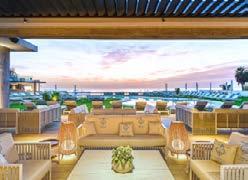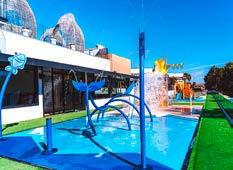 Saúl
Saúl
The
of
TO

 Saúl
Saúl
The
of
TO
CONTENT COORDINATOR
Beneharo Mesa · redaccion@barabaracomunicacion.com
Lavadora de textos
Beneharo Mesa, Enrique Areilza, Astrid da Silva, Alberto Piernas, Aarón Rodríguez González, Raquel Álvarez, Cristina Torres Luzón, Francisco Belín.
CREATIVE DIRECTION AND LAYOUT great · greatttt.com · estudio@greatttt.com
Astrid da Silva
Astrid da Silva, Nacho González, Rocío Eslava, Raquel Álvarez, José Chiyah, Adobe Stock, Pixabay, Unplash.
Capi Cabrera, Ilustre Mario.
ADVERTISING publicidad@barabaracomunicacion.com · 922 897 517
Rodolfo Núñez – President Alfredo Morales – Vicepresident Noelia Curbelo – Institutional Relations and Communication
FOLLOW US ON OUR WEBSITE AND ON SOCIAL MEDIA www.bintercanarias.com · Facebook · Twitter · Instagram · www.revistabinter.com
NT is produced exclusively by BARA-BARA 3.0 S. L. for BINTER. Write to us at buzon@barabaracomunicacion.com.
Neither BINTER or BARA-BARA 3.0 S. L. are responsible for the content of advertising or the opinions expressed by contributors in their articles. All rights reserved. No part of this publication may be reproduced, edited or transmitted by any means or in any form without the express written approval of BARA-BARA 3.0 S. L.
PRINTED BY Gráficas Sabater S. L.With technical assistance from 2informática
Legal Deposit TF 582-2019
NT magazine has used paper obtained from certified sustainably managed forests.
September is synonymous with starting again. After the change of pace enjoyed in summer, everything gradually gets back to normal and an effort is needed to adapt once more to routine. What if we do it differently this time?
I invite you to take advantage of our wide range of flights and destinations and consider taking a break or two –if you can take more, so much the better– that will ease the pain of getting back to normal and help keep the holiday mood alive.
Travel is one of the best remedies for stress and is a wonderful activity that brings with it many benefits. Here at Binter we work day in day out so you can travel in the best way possible and are looked after in the manner you deserve.
This summer we launched the biggest ever schedule of flights outside the Canaries in our history, with up to two hundred flights every week to 32 destinations beyond the islands. The coming winter season will continue in this vein and we have already programmed a 70% increase in seats (430 000 more) on our 35 direct routes to destinations outside the Canaries, thus ensuring the islands will continue to enjoy great connections.
Improving the connectivity of the Canaries has always been the main concern for Binter’s senior management. It was our aim when we acquired the airline from Iberia twenty years ago and remains our aim today. As Canarians, we are conscious that connectivity is fundamental to the development of the region; our Canarian origins are what set us apart in the airline industry … what can be more Canarian than Binter?
That was, in fact, the very question we asked you when we commemorated Binter’s 20th anniversary as a wholly-owned Canarian company and it is a source of great pride for us to form part of the collective heritage of all Canarians. Participants in the competition were entered into a draw, with the winner receiving a voucher for free flights to all the islands for the remainder of the year.
Something else really ‘ours’ is the Binter NightRun, which we are exporting to other cities outside the Canaries that have been smitten by our fascination for night races. Races have already been staged this year in Tenerife and Majorca and others are scheduled for Zaragoza (17 September) and Gran Canaria (22 October), which I would encourage you to sign up for.
Thank you for choosing us and have a GREAT FLIGHT!
Juan A. Ramsden General Coordinator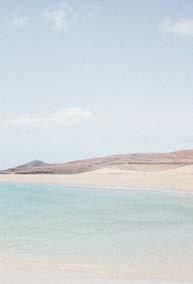
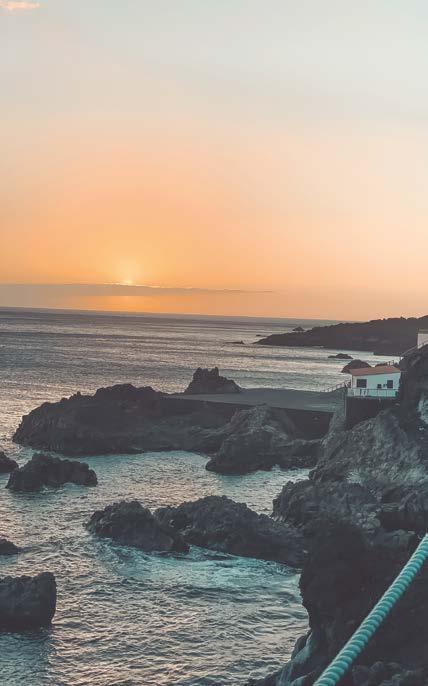





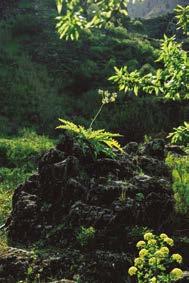

Hard Rock Hotel Tenerife is a hotel with an elegant and contemporary style inspired by music, which awakens emotions and where everything is possible.

Rest like a star and pamper yourself like a legend with unique experiences for all ages, excellent services, and an unmistakable atmosphere.
Exclusive rates for Canarian residents.
Playa Paraíso – Adeje, Tenerife.


Fuencaliente-born Saúl Santos is a photojournalist specialising in landscapes and nature whose work has featured in various publications. These include National Geographic, to which he is a regular contributor. His gaze through the camera lens and his pictures have appeared in over hundreds publications and some thirty front pages of leading magazines and books in Spain and a similar number abroad.
How did your involvement with photography begin?
My first contact with photography was about twenty years ago. It is something I gradually got into thanks to my father, who was a photographer and instilled in me a love for nature, but it did not really attract me that much until then. One of my teachers asked me: «Why don’t you study photography for the sake of your father?». I tried it out to see what it was like, but I was not really drawn to it. However, when I took a camera and developed the photos in the dark room - that moment when you put the negatives in the enlarger, put the photographic paper into a basin with chemicals and watch how a picture emerges from nothing - it was absolute
magic. I think that is when I caught the photography bug and began to take pic tures non-stop, which I still do today.
You are from La Palma and were present when the volcano erupted. What was it like for you?
It was very emotionally charged in all respects, both good and bad. It is difficult to describe it without perhaps hurting people’s feeling. It was indescribable, spectacular, wonderful, and yet very tragic at the same time. I am from Fuencaliente, where the Teneguía volcano emerged in 1971. My father took photos of it at the time. I thought that if a new volcano erupted it would cause a great deal of damage, but I had no idea of
what nature is capable of. I was there for practically the entire 90 days of the eruption, taking pictures and recording it all. Every day we would say: «There’s no way it can surprise us with something new». But it did, especially when we were in the exclusion zone with the scientists. It was an emotionally charged experience photographing such an impressive natural phenomenon. I had tears in my eyes as I contemplated the scene and the personal tragedies the volcano was causing to the people of La Palma. I could speak of many anecdotes, experiences and, above all, the emotions it triggered in me as someone from the island.
Were you in La Palma or somewhere else when it erupted?
By coincidence, that same day I was celebrating my birthday. I didn’t think it would erupt at the time. We did feel an earthquake but, as I had experienced the Teneguía eruption - and as others in the same position have said also - the earth quakes were much stronger then. So, I naturally thought: «As long as the ‘quakes are not as powerful, we won’t get a volcano ». Until that day, when I felt quite a strong one in Santa Cruz de La Palma and that is when I thought that maybe a volcano would emerge. It caught me totally unawares but by the time it really started I was back in the area.
What would you recommend to visit in La Palma? A must-see.
I could suggest a thousand places. I have travelled to many parts of the world that are incomparable in terms of beau ty. However, bearing in mind its small size, La Palma is equally incomparable on account of its different landscapes, climate… An absolute must in La Palma is the Caldera and its surroundings. As a massive fan of nature, I would say that
one thing not to be missed on the island is a sunset or sunrise viewed from the highest parts of Caldera, from Roque de los Muchachos. Anywhere up on the peak is a must for me. There are many places like the Los Tilos Forest and the Route of the Volcanoes but if I had to choose my number one spot I think it would be the island’s peaks.
-
I had tears in my eyes as I contemplated the scene and the personal tragedies the volcano was causing to the people of La Palma
-
You have been to many parts of the world. Which ones have impressed you most?
Patagonia is the place I have always dreamed of and I discovered just why when I went there. I think it was there that I truly realised that I wanted to work in travel photography. I am grateful to it for another reason too: my first front cover for National Geographic was a photo from Patagonia.
What does photography mean to you?
It is part and parcel of my life. When I am swamped or on a job that doesn’t satisfy me entirely, or if I have gone four or five days without taking pictures, I feel like I really need to get the camera out. Many people told me that I would lose my passion for it as soon as I started doing it professionally. They were so wrong! My passion grows by the day because I always want to pass on the emotions of what I see to those looking at one of my photos.
Read the full interview in revistabinter.com
Interview. Saúl Santos










 By Enrique Areilza* Illustrated by Ilustre Mario
By Enrique Areilza* Illustrated by Ilustre Mario
When it comes to asking how the holidays went, some bosses do, others don’t. Some employees see it is appropriate and a friendly gesture denoting interest, others an unacceptable intrusion. Certain lines of thinking in science argue in favour of the close and friendly leadership approach, others advocate a sterner and more distant approach. The issue at the heart of all this is how to come through such situations successfully?
From what we have seen, the difference is astronomical. The result is unsurprising given the vast combination of variables. To begin with, personality: an introvert will not see things the same way as someone who is sociable. Then there is the perception as to the true intention of the question, which some will see as sincere and positive whereas
others will interpret it as manipulation, pure and simple. Another variable is the employee’s relationship with, and opinion of, the manager: good person versus absolute bastard, etc., etc.
Following on from the above, the difficulty of keeping everyone happy is inversely proportional to the disparity of
Search.characters in the team. A poor team lineup is bad for everyone; it will never rain enough for each and every one of them. You might think that the company or the boss are at fault for not defining the firm’s culture and values and hiring em ployees who fit these. Let us not delude ourselves, however: we all bear responsibility in hiring decisions. The hirer and the person hired. Just as in a marriage, the aim is to be happy and live happily ever after, so the more open and sin cere we are and the less we cheat when playing solitary, the more likely we are to succeed. In our line of business, all too frequently we see leaders who oversell the positions they want to fill, just as ap plicants overstate their CVs, enthusiasm and promised commitment.
According to the various corporative cultures, workplaces must or should be tailored to different rungs on the pyramid. The most basic companies seek to have the workspace address the lowest rungs only: basic needs, safety and protection (essentially, wages today).
However, other organisations believe that the company should contribute to higher needs: a sense of belonging and even recognition and self-fulfilment. In the first case (basic needs), there would appear to be no place for questions concerning holidays, whereas in the second they would be obligatory. Irrespective of the foregoing, or in addition to it, the pandemic-enforced rapid changes to remote working models are tilting corporative cultures towards the second kind, due either to belief or to need.

Although the debate concerning the best leadership formulas is never-ending, unresolvable and, what’s more, shifts back
and forth depending on the economic climate and the generation group that is dominant in the team, the care leadership model of the English-speaking world has the upper hand today compared to the impervious autocratic model. However, even if many bosses understand that they are better liked when they come across as friendly rather than tough, they feel also that too much camaraderie can undermine respect. As can be seen, bosses too are affected by the questions regarding questions about holidays.
After consulting the various positions and arguments, we believe it is better to be a well-meaning and friendly manager, even if we are also realists and conscious that the result is the ultimate goal. It is best to ask and, even better, observe before doing so. With a little forward analysis, we can anticipate how people will respond. Despite this, if we have not realised this and things turn out badly, look for a quick way out or do a U-turn.
-
-
As employees we may respond in different ways, ranging from being sincere and friendly to making a diplomatic exit. Anything is valid as long as we endeavour not to damage relationships or reveal our private life beyond self-set limits.

That said, the best advice is to have a great time whether or not you talk about it afterwards.
Have a great trip, whether going away or coming back.
A poor team line-up is bad for everyone; it will never rain enough for each and every one of them.


Hard Rock Hotel Tenerife rededicates the entire month of October to the Hard Rock Pinktober program, in support of breast cancer awareness and research.
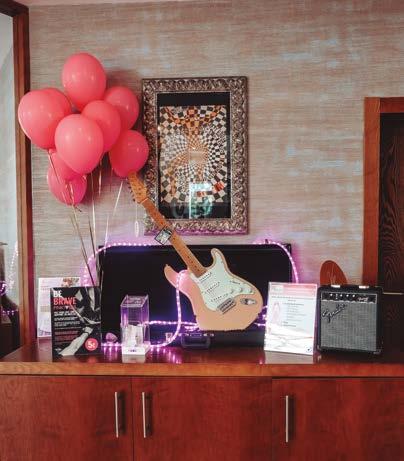
Throughout the month, fundraising campaigns will be carried out through the different outlets of the hotel and special events, and the proceeds will benefit the Association Ámate of Tenerife.

“Hard Rock Hotel Tenerife is honored to support those in need, especially those in our local community through Asociación Ámate during PINKTOBER,” said Javier Alique, General Manager at Hard Rock Hotel Tenerife.
“It is a privilege to bring our guests and community members together through fundraising events that deliver a unifying message of strength, hope and awareness for those affected by this disease.”
The second quarter of 2022 saw the number of people employed in the tourism industry rise to 2, 718 ,098, an increase of 16.8 % compared to the period April-June in 2021 and the same increase compared to the first quarter of the current year. According to the latest figures from the Active Population Survey (EPA) reported by Turespaña, the industry accounted for 49.1 % of all new jobs in the Spanish economy.
During the quarter, the economy recorded 976, 000 more jobs than in 2021, 49.1 % of them tourism-related and tourism now accounts for 13.3 % of total employment in Spain.
The number of people employed rose in all regions except La Rioja, Ceuta, Melilla, Asturias and Extremadura. The regions where most tourism is concen -
trated (Catalonia, Andalusia, Madrid, Canary Islands, Balearic Islands and Valencia) account for the bulk of jobs in the sector, together representing 74.5 % of the total employment in tourism in the second quarter according to the Hosteltur website.
The most eagerly anticipated part of Tijarafe’s festivities in honour of Our Lady of Candelaria takes place in the town square in the early hours of 8 September with the Dance of the Devil, in which the evil figure literally spits out fireworks.
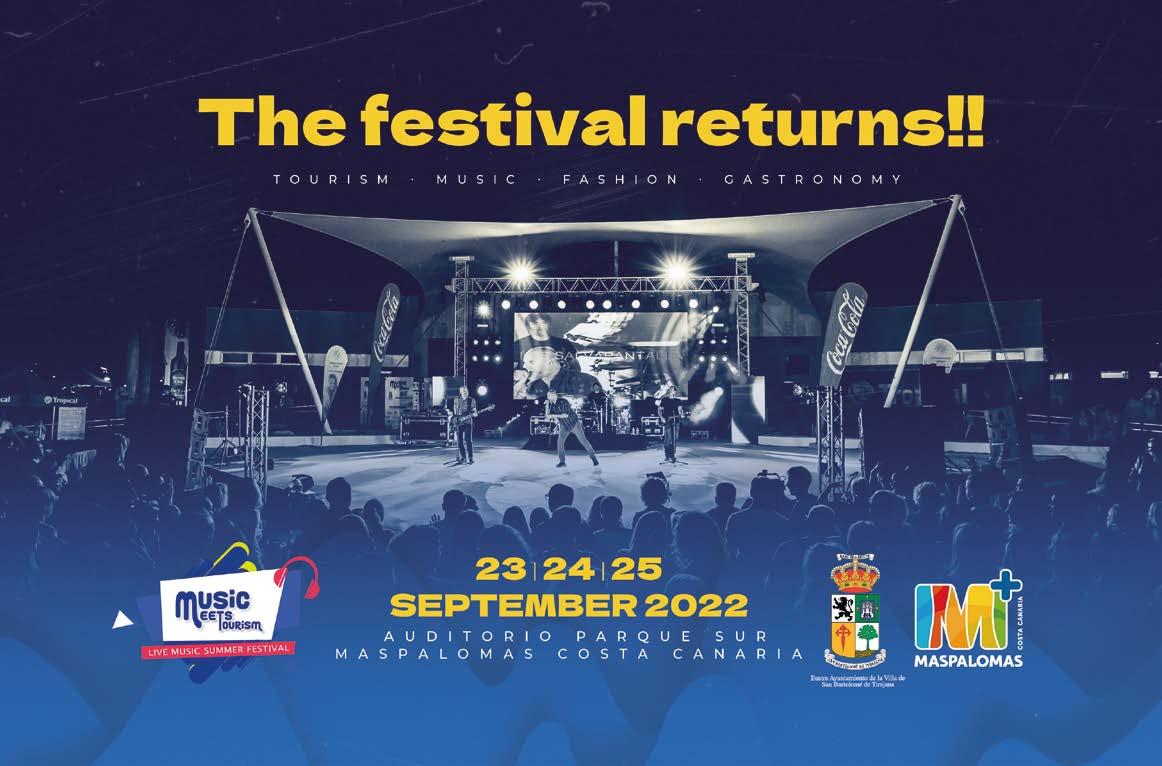

The devil’s arrival is preceded by giant papier-maché figures who interrupt
the open-air dancing without warning. After several minutes of firework frenzy, the show ends when the head of the devil explodes, symbolising the triumph of good over evil. The celebration has benefited from official protection as a cultural asset since 2007 and was later designated a Fiesta of Tourist Interest by the Canarian authorities in 2011.

Five wind farms will supply 11,000 homes across La Gomera with renewable energy, generating twelve megawatts daily that will not only cover the island’s entire electricity needs but also create a surplus for export. In addition, the farms will help prevent over 23,000 tonnes of CO2 from being given off into the atmosphere, thus making a significant contribution to the decarbonisation of the Canar ies which is scheduled for 2040.
Galician renewable energies multinational Ecoener will supply sustainable energy to the whole island thanks to the five new wind farms currently under construction. The farms will provide a total output of 12 MW at a cost of around 17 million euros. The initiative is part of
the Sustainable La Gomera Project, which includes six technologically-innovative energy infrastructures located in different parts of the island and is based on photovoltaic power stations, energy storage, micro-networks and intelligent energy management systems.


The Dantazul Group Vocational Training Centre is a private centre approved by the Canarian Ministry of Education, Universities, Culture and Sport. We offer higher-level programmes in Dental Hy giene, Dental Prosthesis and Prosthetic Audiology, courses which facilitate access to university studies, preferably in a health discipline. We also offer approved specialist courses, including dental radiodiagnosis equipment operator.
With over two decades of experience in course delivery, our centre prides itself not just on training skilled professionals but also on being awarded the 2019 Inter national Business Innovation Prize, which we received at the Museum of Technology in Berlin, and the SME Socially Re sponsible Business Award in 2000.


 By Astrid da Silva
By Astrid da Silva
At 14:11 on 19 September 2021, La Palma was deafened by a giant bang. The predictions had come true and, from its place in the heart of the island, the Cumbre Vieja volcano gave off an incredible roar, covering everywhere in ash and lava. The whole of the Canaries was on tenterhooks until silence was restored 85 days later. The volcano changed the face of the island but did not alter a single inch of its beauty. Now, more than ever, is the time to go back to La Palma! Below are a series of good reasons to visit.
In the aftermath of the longest eruption in the island’s history, the entire local population is keen to get back to normal. To do so, we need to go back to enjoy ing everything the island has to offer: stunning scenery, a host of activities to connect with nature, and wonderful food. It is the ideal destination for families and couples, as well as sports enthusiasts keen to venture into the most spectacular landscapes found in the Canaries.
La Palma was designated a World Biosphere Reserve in 2002 due primarily to its natural spaces and the unique biodiversity of its flora and ecosystems. A great way to admire this beauty to the full is by walking along some of the 700 km of paths and trails that crisscross

the island. It is the perfect destination for lovers of hiking, with routes to suit all tastes and ranging from volcanic surroundings with the sea as a backdrop to humid forests.
-
Towards the south lie the Fuencaliente salt flats which make for a landscape full of contrast between the black volcanic soil and the white salt
-
One route not to be missed takes us through the Los Tilos Forest in the Las Nieves Natural Park. Here, visitors are ac-
companied by the whispering of the water all the way up to the majestic water fall. It is a magical setting where you can admire the splendour of the lush green ery of one of earth’s oldest laurel forests. A number of trails of varying degrees of difficulty can be explored from here.
A visit to the Caldera de Taburiente National Park is a must too as it is one of the island’s iconic locations for its spectacular scenery, sea of clouds and lush interior full of springs and water falls that give rise to little streams. The setting looks as if it is something from a fairy tale. You can apply for authorisation to camp in the designated camping area and enjoy a unique experience in the very heart of the Caldera, waking in the
mountains and sleeping under a starfilled sky. The totally pristine skies –vir tually free of light pollution– have made La Palma one of the world’s foremost locations for astronomical observation and for this very reason the island was designated the Starlight Foundation’s first Reserve.
Inside the Park we will find the Roque de los Muchachos, which is the island’s highest point at 2426 metres and is full of viewpoints offering spectacular views of the Caldera itself and of neighbouring islands. On clear days you can see Ten erife, El Hierro and La Gomera.
Towards the south lie the Fuencali ente salt flats, which make for a land -

scape full of contrast between the black volcanic soil and the white salt, in addition to the amazing colours cast on them by the sea. It is a great spot not just to watch dusk fall but also for fine cuisine. Located here is a restaurant which has been awarded a Bib Gourmand in the Michelin Guide.
The above are just a few examples of what a trip to La Palma has to offer. Although the face of the Aridane Valley has been changed by the recent volcano eruption, it continues to be as spectacu lar as ever. What’s more, experience tells us that eruptions can create wonderful new spaces, a good example being the Echentive beach formed by the eruption of the Teneguía volcano in 1971. Its black sand and natural aquamarine pools make it unique. The route taken by the lava as it flowed from Cumbre Vieja down to the coast in the recent eruption is likely
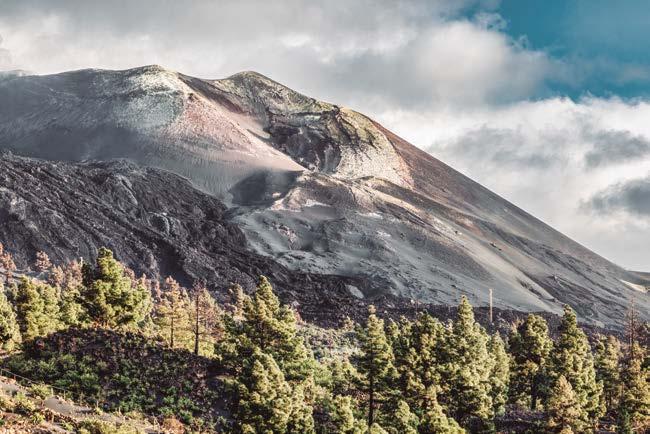
to create new spots that will add to the incalculable beauty of La Palma, which is rightfully known in Spanish as La Isla Bonita (The Pretty Island). La Palma needs us now more than ever. It needs responsible and sustainable tourism, one practised by travellers who realise what a great treasure it is and that it requires all of us to look after and preserve it.
From 1,000 points one-way or earn up to 200 points one-way.
For terms and conditions, see bintermas.com Ask our cabin crew for a leaflet or register with bintermas.com and start earning on your Binter flights and with more than 30 programme partners.


It is called the ‘Pretty Island’ for many reasons: for its imposing Caldera de Taburiente crater, fairy-tale forests and waterfalls, pristine skies, volcanoes, well-kept towns, gastronomy, crafts and traditions, and, above all, its people.
Binter operates daily flights to La Palma from Tenerife, Gran Canaria and Lanzarote, with several flights per week from Fuerteventura in summer also.
H10 Taburiente Playa: on the seafront just five kilometres from the airport and Santa Cruz de La Palma. An ideal base from which to visit the Pretty Island. La Palma & Teneguía Princess Vital & Fitness: located on a cliff overlooking the sea and surrounded by banana plantations, this hotel is ideal for a few days holiday in an oasis of tranquility with the best climate on the island.
Good food is guaranteed in La Palma. Its smoked Protected Designation of Origin cheeses, creamy ‘wrinkled’ potatoes served with delicious La Palma mojo sauce, wines made with malvasía grapes, tasty tropical fruit and tempting pastries will guarantee many great dining occasions.
Caldera de Taburiente: an impressive caldera eight kilometres across and surrounded by the island’s highest peaks. A visit will leave you lost for words.
Tajogaite Volcano: the recent eruption has led to the emergence of a new volcano in the Cumbre Vieja area and changed the shape of the Aridane valley. Impressive.
Roque de los Muchachos Observatory: one of the world’s most important observatories is located at Roque de los Muchachos on the summit. A massive privilege.
Santa Cruz de La Palma: the capital of La Palma is a quaint and well-preserved colonial city which has retained its original charm with its cobbled streets, small squares, churches and colourful balconies. Enjoy its shops and restaurants.
Porís de Candelaria: a tiny fishing community hidden in an imposing cave at the edge of turquoise waters. Tempting, is it not?
La Fajana pools: on the Barlovento coast in the north of the island you will find some of La Palma’s best natural pools.
More information:
www.revistabinter.com and www.canariasviaja.com

 By Alberto Piernas Medina
By Alberto Piernas Medina
The Atlantic Ocean gives a magical sigh on the streets of A Coruña and in the nearby Fragas do Eume forest, both of which are examples of a legendary coast steeped in history, tales and storybook wood lands. This year more than ever, all eyes are on a city which is as much a beacon as it is fascinating.
These past couple of years we have sailed on a sea full of uncertainty and doubt. Or rather, an ocean. For that reason, this summer we need new lighthouses to bring us back to the world and discover all the magic which was taken from us. We have one here: countless sailors have been drawn to the Tower of Hercules, the world’s oldest functioning lighthouse. Gazing at the sea from the Wind Rose circle, all cardi nal points converge on this moment.
The Tower of Hercules Sculpture Park is an open invitation to stroll along fourteen kilometres of promenade with the outline of the Roman lighthouse overlooking the Atlantic always in sight. This World Heritage site is the best possible reason to venture into A Coruña, a city where the breeze always has something to tell you.
It might tell you about the modern ist Plaza de María Pita; beaches such as Riazor, where the heavens rest on their elbows and remind you of the true meaning of homesickness. A netmaker on a shore, stitching together the nets of history; the ocean looking its reflection in the mirror offered by the glazed balconies of the Avenida de La Marina; a few metres away, someone enjoying a tapa of octopus and an Estrella Galicia beer. Beer lovers are in luck as the city is home to MEGA, a space where can learn more about the history of this iconic beer through a range of sensory experi ences and pairings.
-
So says the legendary Finisterre lighthouse.
-
Curiously, the world recommences where it ends. So says the legendary Finisterre lighthouse, once considered the end of the earth, or its counterpart at Cabo Vilán. Both are symbols of the Costa da Morte (Coast of Death) that reverberates in the shape of colourful boats, age-old rituals, and forests brimming with natural life. Rosalía Castro alerted to this in one of her poems: «They say that the plants do not speak, not the brooks, nor the birds, Nor the waves with their roar, not with their brilliance the stars. So they say: but it is not true, for always when I go by, they whisper about me and say… ». The Fragas do Eume for est is a perfect example of this exuberant canopy which has a life of its own.
The Fragas do Eume Natural Park is located 45 kilometres by road from A Coruña, through delightful villages such
as Bergondo and Miño. For those who do not know, fraga in Galician means a forest with trees from different species, in this case oaks and chestnuts that form a deciduous mantle which also features hazel and ash trees, naturally occurring trees and even holly trees. A nature orchestrated by invisible meigas (Galician witches) flourishes on the banks of the River Eume, whose waters are audible at all times and serve as an excellent guide. Fragas do Eume - a combination of a scene from a Tim Barton film and a bucolic poem - is best explored on foot by venturing into its forests along the many available walks.
As you wander among the ferns you feel as if you are lost in time and space. Nestled in the undergrowth, the 10th century Caaveiro monastery offers enticing views from its many vantage points. Further along you will see cur ripas, curious circular constructions made of stone which were used to store chestnut in bygone days. The sound of the river blends with that of the ocean in the distance. Here the elements merge and the ash trees talk about you. About your destiny and your past, about the life you still have to live.
Because in A Coruña one world ends and another begins, like a lighthouse which attracts all the waves on earth.
From 12,000 points one-way or earn up to 1200 points one-way.
For terms and conditions, see bintermas.com Ask our cabin crew for a leaflet or register with bintermas.com and start earning on your Binter flights and with more than 30 programme partners.
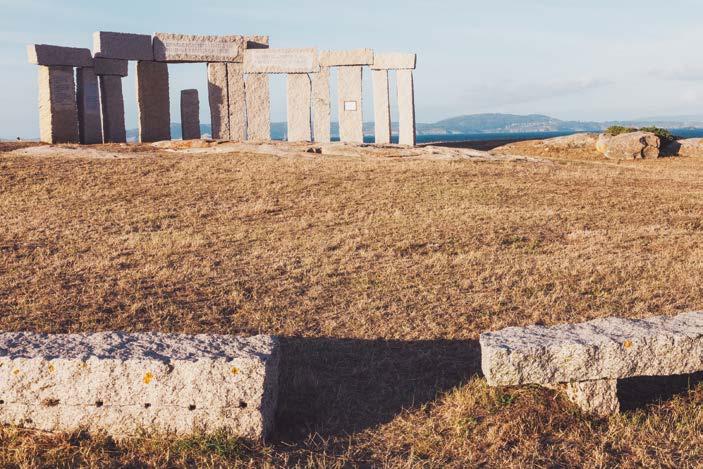

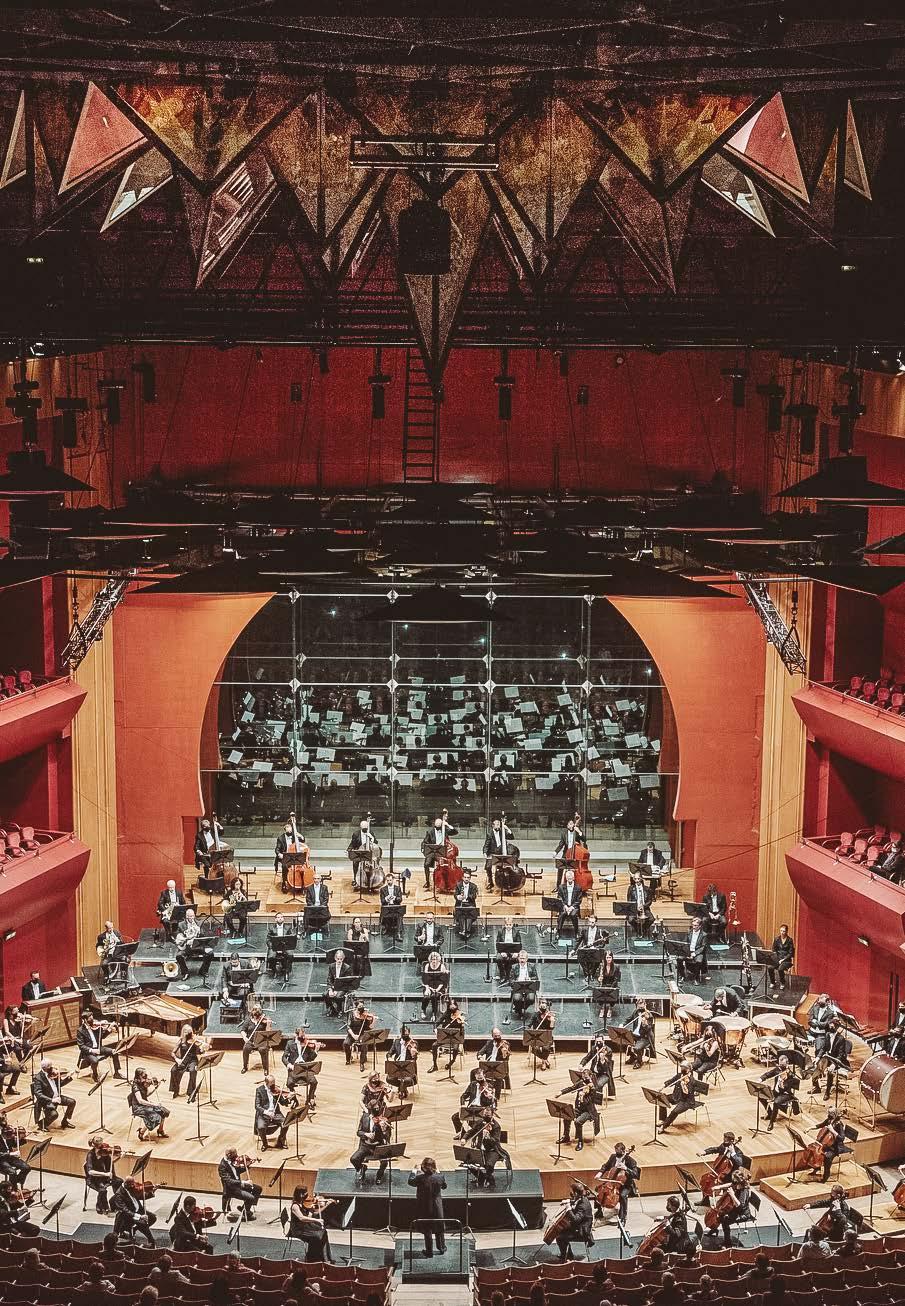
Music has been part of the DNA of Las Palmas de Gran Canaria ever since the city, which is now the biggest in the Canaries, was founded in 1478.
Permanent exposure to outside influences, the constant concern of society to keep abreast of current trends, and an ever-present heritage of its own have combined to define the character of the Gran Canaria capital.
Visitors to Las Palmas de Gran Canaria can get to know it in a unique way through its musical ties. Through its comprehensive year-round programme as well as its important heritage and its most iconic buildings. The Cathedral, which already boasted a music chapel in the late 15th century; the emblematic Literary Circle; the city’s leading tem ples of music: the Pérez Galdós Theatre and Alfredo Kraus Auditorium - situated respectively in the old quarter and on the seafront at Las Canteras Beach - which stand in harmony with each other.
The history of Las Palmas is replete with music. The Las Palmas Philhar monic Society (the oldest in Spain) was
created in 1845 and back then the city hosted important concerts by taking advantage of visits by musicians and performers as they travelled between America and Europe. That same passion for classical music is very much alive today as Las Palmas is one of the major host cities of the Canary Islands’ Classical Music Festival, and is home also to Santa Catalina Classics and its own opera season.
Las Palmas de Gran Canaria always has something in its programme to include in your visit. You can admire the statue of the magnificent Canarian tenor Alfredo Kraus who stands guard over Las Canteras, stroll along the prome nade from end to end and finish in the Santa Catalina or Doramas parks, where you can take in a concert.
Music is part of the history of the city as well as its daily life, with options great and small available throughout the year.
Photo by Nacho GonzálezThe Corralejo Dunes Natural Park, situated in the municipality of La Oliva, was formed organically and gradually through the disintegration and atomisation of shells of molluscs, bivalves and other marine organisms with hard outer shells. The Dunes occupy an area of 2600 hectares on Fuerteventura’s northeast coast.

César Manrique Cabrera (1919, Arrecife-1992, Teguise) was a painter, sculptor and architecture from Lanzarote and is considered one of the most important Canarian artists of all time. A trademark feature of his work is his respect for the environment and the exaltation of the architectural values of local traditions blended with modern conceptions. His chief works in Lanzarote include the Jameos del Agua caves, the El Río Viewpoint, the Monument to Peasant Farmers, and the Cactus Gardens. Works situated elsewhere in the Canaries include the Costa Martiánez lido in Puerto de la Cruz in Tenerife; the El Palmarejo Viewpoint in La Gomera; and the La Peña Viewpoint in El Hierro. Further afield, he designed the Mediterranean Maritime Park in Ceuta and a major shopping mall in Madrid.
 Fuerteventura.
César Manrique.
Fuerteventura.
César Manrique.
A bicycle can be a great travelling companion and one of the best ways to get to know La Graciosa is to follow its many cycling routes, including several circular ones around the island. Without doubt, a different way to tour this paradise while taking in the scenery.

This plant, which does not have branches, is formed by hundreds of flow ers that emerge from the centre of the rosette. It can reach heights of between two and three metres. The flower is pink ish in colour and is endemic to La Palma, whereas the red variety is endemic to Tenerife. It grows in high mountain are as, usually above 1600 metres

Cueva Pintada Museum and Archaeology Park
This museum is one of Gran Canaria’s most important archaeological spaces. Situated in Gáldar town centre, its pur pose is to ensure the conservation one of the most unique sites in the Canaries, as well as research and dissemination activities relating to it.
It was discovered in 1862, but the excavations undertaken since 1987 have uncovered a settlement of over fifty dwellings and artificial caves that were part of pre-Hispanic Agáldar (Gáldar’s old name).
 Bikes in La Graciosa. Pink Tajinaste.
Cueva Pintada Museum and Archaeology Park.
Bikes in La Graciosa. Pink Tajinaste.
Cueva Pintada Museum and Archaeology Park.
Similar in appearance to a small cake and with a characteristic flower shape, quesadilla is a typical El Hierro dessert whose origins can be traced back to the early 20th century and the family owners of the Adrián Gutiérrez & Daughters factory. Its main ingredient is local cheese and a mould is needed to provide the flower or star shape, if you want it to look like the original. Traditional quesadillas are made in a wood-fired oven.

La Gomera’s whistled language

La Gomera’s whistled language is one of the Canaries’ most unique manifestations, not to mention a living tradition from the Islands’ pre-Hispanic days. The whistling has been used on the island since time immemorial to communicate over long distances. It has no pre-established codes but is rather an articulated, simplified and unconventional language that enables a limited range of messages to be conveyed by reproducing, by means of whistling, the sound characteristics of a spoken language.
La Laja rock pool
Located in San Juan de la Rambla, the La Laja charco or natural rock pool is one of north Tenerife’s iconic swimming spots. Around twenty metres in diameter and surrounded by what was once lava in its day, it is ideal for a dip. Access to the pool is down a steep and stepped path, but it is well worth it.
 Quesadilla cakes from El Hierro. La Gomera’s whistled language.
La Laja rock pool.
Quesadilla cakes from El Hierro. La Gomera’s whistled language.
La Laja rock pool.


Secrets Bahía Real, located in an idyllic natural enclave on the island of Fuerteventura. A hotel designed for relaxation and enjoyment of the most authentic pleasures for adults.

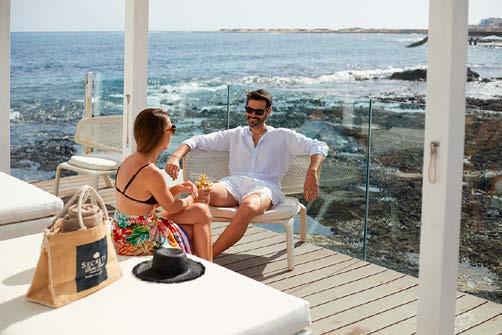



The Hotel Fariones, an icon of Lanzarote’s tourist industry, was the island’s first hotel when it was built in the 1960s. It reopened in 2020 as an exclusive 5-star hotel, retaining the special atmosphere that has always set it apart as a dream destination in the Canaries.
The hotel is thriving at present having been singled out as one of the best in the world in the 2021-2022 Traveller’s Choice Awards. Its essence and stunningly beautiful garden full of tropical and subtropical vegetation over forty years old sur round the main infinity pool. Everything is integrated to perfection in one of the best locations in Puerto del Carmen, with direct access to three beaches.
The Hotel Fariones offers guests modern and comfortable rooms, with spacious terraces directly overlooking the sea, all blended into an artistic map that speaks of the landscapes and authentic features of the Island of Volca noes. Moreover, our suites offer privileged views of Fuerteventura and the island of Lobos from the rooftop pool.
A walk through the hotel lobby enables you to admire artist César Manrique’s work Lanzarote and the collection of handcrafted pottery by local artisans that decorates the Bella Lucía restaurant, which offers a range of creative dishes and showcooking.
Our gastronomic universe also in cludes the elegant Erizo Macaronesian restaurant, where you can enjoy de lightful dishes with the authentic taste of the sea; the Kaori Asian restaurant, a culinary jewel which reinvents traditional Asian cuisine with contemporary twists, and the La Barra Food & Drinks terrace, ideal for a light dinner accompanied by live music.
An added feature of the hotel’s gas tronomic offering is its extensive use of locally-sourced, zero food-miles products from Finca de Uga (@finca_de_uga), together with exclusive wines from the Stratvs Winery (@bodegastratvs).
Tel. 928 510 175 Hotelfariones.es - @hotelfariones

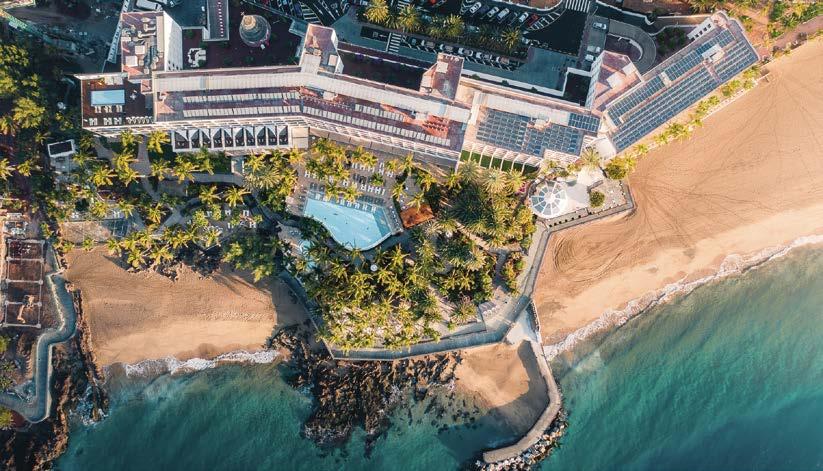

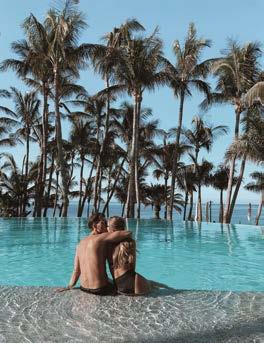

 Infinity pool.
Aerial view of Hotel Fariones.
Superior double room with sea view.
Royal Suite.
37 Kaori Restaurant, for those who love Asian food.
Infinity pool.
Aerial view of Hotel Fariones.
Superior double room with sea view.
Royal Suite.
37 Kaori Restaurant, for those who love Asian food.
 By Aarón Rodríguez González Photos by Rocío Eslava
By Aarón Rodríguez González Photos by Rocío Eslava
The small village of Fagajesto lies between Montaña Gorda and the Lomo del Palo ridge. For centuries, its livelihood has been based on the farming activities and livestock grazing that have given Gran Canaria’s beautiful interior its character and way of life. The village, which is situated more than one thousand metres above sea level in an area frequently shrouded in the mist blown in by the trade winds, is the starting point for a walk that will take us to the natural harbour of Agaete in the northwest of the «miniature continent» of Gran Canaria.
The first section of this walk takes us through the narrow Los Cabucos ravine which, after approximately two kilometres of winding trail, brings us to El Sao, situated just over 460 metres above sea level along the Agaete Ravine.
-
-
Throughout this initial stretch we will enjoy stunning views of the head of the impressive basin, which extends northwest from the eastern foothills of the
island’s iconic Tamadaba mountains. The trail now follows the route of the ravine and is less steep here. The view is spectacular on reaching Las Vueltas mountain. The up to now narrow sides of the ravine widen considerably and reveal a fertile and beautiful valley ahead, more than three hundred metres in height below our current position. In the distance, as if emerging from the sea, the outline of the Anaga Mountains in north-east Tenerife can be seen. After taking in this exceptional view for a while, we walk down into the bottom of the valley and follow the trail that runs parallel to the ravine, through the districts of San Pedro, Las Cuevecillas and La Suerte. The last part of the walk takes us along the streets of Agaete as far as the church of Our Lady of the Conception.
The up to now narrow sides of the ravine widen considerably and reveal a fertile and beautiful valley ahead
 Walks. Gran Canaria. Fagajesto-Agaete
Walks. Gran Canaria. Fagajesto-Agaete
Positive Elevation: 150 metres
Negative Elevation: 1130 metres
Length: 9.3 km
Highest point: 1020 metres
Lowest point: 40 metres
Nearby places of interest: although the walk does not actually go through protected natural spaces, it does take us near two of Gran Canaria’s most special and impressive areas. These are the Protected Landscapes of Las Cumbres, south-east of Fagajesto, and in particular the Tamadaba Natural Park to the south-west.


Notes: the walk is almost entire ly downhill and, despite being relatively short, it can be quite challenging on the knees. Walk ing poles are recommended, therefore. As the starting point is at over one thousand metres, the panoramic views through out are fantastic.
Did you know? Agaete, together with its natural harbour and the defence tower built here by the Castilians, was a key location for the conquistadors in terms of quelling the fierce resistance put up by the indigenous inhab itants of northern Gran Canaria.
 Walks. Gran Canaria. Fagajesto-Agaete
FAGAJESTO Montaña de las Vueltas San Pedro La Suerte
Walks. Gran Canaria. Fagajesto-Agaete
FAGAJESTO Montaña de las Vueltas San Pedro La Suerte

 By Raquel Álvarez
Photos by José Chiyah
By Raquel Álvarez
Photos by José Chiyah
Some tourists unfamiliar with the Canary Islands expect heavenly beaches everywhere and may feel disappointed if their chosen destination does not offer, on the doorstep of their hotel, postcard pictures like the beaches featured here, bearing in mind that the Canaries boast an endless list that would easily fill several books. However, if there is one beach that meets the at times overused description of ‘paradise’ and ‘unforgettable beach’, without doubt it is Sotavento in Pájara (Fuerteventura). Although it matches the description at all times, when you walk on its delicate and fine golden sands or take a dip in its crystal-clear waters at low tide the best thing is to stay silent and just close your eyes. The rest is pure delight on not one but a collection of beaches on the island that offers the most coves and surprises full of sand, sun and salt anywhere in the Canaries.
Location: Jandía on Fuerteventura’s south-east coast
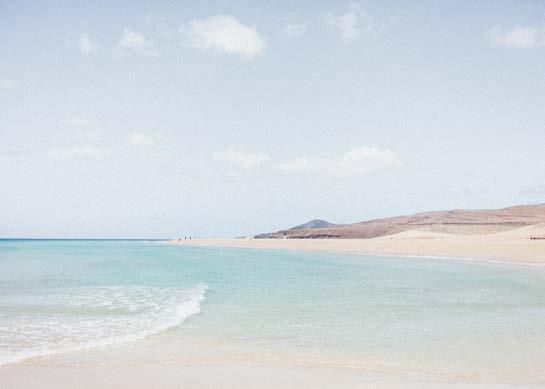
Lifeguards: Yes
Surfing beach: Yes
Restaurants: Yes
Toilets: Yes Showers: No
Sunbeds and umbrellas: Yes
Adapted for the disabled : Yes
Parking: Yes
Public transport : Yes
Dogs: No
Interesting fact : The high tide creates small lagoons you can swim in
Fuerteventura is a beach island with countless spots worth visiting to enjoy the sun, fine (mostly golden) sands and the refreshing waters of the Atlantic. However, the Jandía Peninsula, a limb-like extension that gives the island its characteristic shape, beats all records for its succession of heavenly bays stretching from the harbour at Morro Jable to the area known as Costa Calma. A collection of unforgettable beaches that include Matorral, Esquinzo, Mal Nombre and many others, and whose crowning glory is Sotavento Beach.
All you need to do is pull over, park safely next to the main road and enjoy this unforgettable desert which offers a very happy ending when you enter the sea. If you look at a paper or Internet map of Fuerteventura, this appears as the most desert-like and yellow strip due to its fine sands. A gigantic conservation area stretching from Sotavento to Barlovento.
-
If you look at a paper or Internet map of Fuerteventura, this appears as the most desertlike and yellow strip due to its fine sands
-
The select collection of coves at Sotavento is preceded by spectacular dunes through which you can improvise a path to get to the eagerly-anticipated shore which is noted for its generally calm sea, a central zone (Lagoon Beach) famous the world over for the lagoons
created at low tide, the presence of windsurfers, the sheer size of an area that resembles the delta of a major river, the pristine surroundings, and the crystal-clear and semi-warm waters which get colder the further out from the shore you go.


There is a parking area next to the beach, which also has bars and surfing schools where you can hire the equipment required to enjoy an experience of a very different kind in ideal winds and waters. The location is so immense that there are many parts where you can enjoy the most authentic of solitudes; freedom and tolerance are enhanced by the nudist areas. The exten sive and varied provision available has something for everyone: family zones, walks of all kinds, swimming in tranquil coves, areas with a choice of waves, a crucible of Atlantic blue colours, parts too deep to stand in, not to mention the impression that paradise is endless when the tide goes out.
Many tourists who visit the Canaries might feel disappointed that there are no immense and heavenly beaches next to their hotel. This feeling can be remedied in many cases by a short drive and, in that respect, there is no way that Sotavento will prove a disappointment. The worst thing of all is that many people in the Canaries still do not realise it. It may seem hard to believe, but we do indeed have such postcard pictures right here in our Islands, which may be small in terms of the size of the earth but are gigantic in terms of unforgettable attractions.
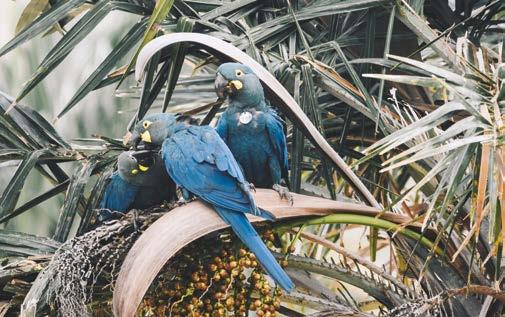
Loro Parque Fundación achieves a new milestone in the conservation of exotic species: the first Lear’s Macaw chick was born in situ (in its natural habitat) from birds born and bred ex situ (outside their natural habitat).
The pair of Lear’s Macaws that were born and bred at Loro Parque Fundación, the world’s largest living parrot genetic reserve, and subsequently introduced to the Brazilian caatinga, have given birth to their first offspring.
The reintroduced birds that were born and raised under human care at Loro Parque Fundación have not only been
able to survive in their natural habitat and fully adapt to their environment, but have also been able to reproduce, largely thanks to the work of the Foundation’s team of experts.
This is yet another example of how animal care in zoos serves as an effective tool to prevent the extinction of critically endangered species.

 By Cristina Torres Luzón Illustrated by Ilustre Mario
By Cristina Torres Luzón Illustrated by Ilustre Mario
The number of suicide deaths increases every year in Spain. Taboos surrounding this public health problem have been broken in recent years thanks to awareness campaigns and the roll-out of resources, even if the measures currently available to tackle it are still inadequate. Lives are saved when the reality of suicide is made visible, the myths surrounding it are dispelled and channels of support are created.
The fact that certain topics and sit uations are considered cultural taboos by society is one of the main barriers to addressing them. One of the biggest of these in today’s society is suicide.
Suicide is a serious public health problem. According to the World Health Organisation (WHO), a suicide occurs every forty seconds. In Spain there are an average of eleven suicide deaths every day and a further 200 attempts. The problem has become more acute in recent years due to the pandemic and suicide rates have risen. According to the National Institute of Statistics, in
2020 the Canary Islands ranked fourth among Spain’s regions in terms of suicides per 100,000 of the population.
Suicidal behaviour can present in anyone and at any time of life, although certain risk factors increase its likelihood. Suffering schizophrenia increases the likelihood ninefold, depression 21-fold, while drug addiction increases it 86 times.
Many cases occur in individuals who act rashly when faced by a crisis situation (financial problems, break-up of a relationship, bereavement, pain and chronic illness …).
Higher suicide rates are seen in vul nerable people and in those who suffer discrimination, including migrants, refugees, homosexuals, bisexuals, transexuals and intersex persons. However, the main risk factor is, by some distance, a previous suicide attempt.
Delving deeper into this societal problem, we should not ignore the myths that are wrongly associated with suicide and cause untold harm. For example, the myth that talking about suicide is counterproductive: it has been considered historically that it is better not to talk about it so as not to encourage it. The opposite is true: denying some one the opportunity to express suicidal thoughts and get the negative feelings that trigger them off their chest stops them from releasing their suffering and contemplating other possible solutions. This increases the person’s isolation and makes it difficult to put support provision in place.
Some suicide-related myths that continue to be a barrier to care for sufferers include the belief that «someone who really wants to end their life does not give advance notice». In fact, it is impor tant to remember that there are various warning lights that should alert us that something is wrong.
Expressions of despair, a desire to die, medication not taken, comments such as «I’m tired, I don’t think it is worth carrying on», increased drinking or drug-taking, and cutting off family and friends are just some examples of warnings that a person is suffering and needs help.
Another myth is that «suicide at tempts are just a form of attention-seeking» when in fact they are cries for help. How can we help? Invite the person to
talk about it, listen without judging and encourage them to seek professional help, help them acknowledge their strong points and their ability to make decisions, encourage them to stay in touch, to not underestimate what is happening to them and their feelings, help them prepare a safety plan they can draw on in times of crisis.
-
-
Luckily, other myths have largely been dispelled: «The media should not talk about suicide so as not to encour age it» or «suicide cannot be prevented». In Spain, recent years have seen the problem acquire greater visibility and May 2022 saw the introduction of the Spanish government’s free, anonymous and confidential 024 hotline, which is available 24/7 to help those experiencing suicide thoughts, as well as their family and friends.
It should be remembered also that the suffering begins in the person who harbours suicidal thoughts but then spreads to their loved ones. The social stigma which suicide causes in family and friends, coupled with the feeling of «guilt» or powerlessness, makes grieving difficult. Denying the reality of the situation merely delays the solution. The best option for everyone is to accept that something is wrong and seek help.
How can we help? Invite the person to talk about it, listen without judging and encourage them to seek professional helpSuicidal behaviour hotline

Every year the Canarian Health Service conducts a survey to canvas the opinion of patients admitted across its hospitals with regard to the care received. Categories covered include how they felt they were treated, the information provided, whether staff were welcoming, and the quality of the care.
According to the Hospital Satisfaction Survey conducted in 2021 with around one thousand patients at the time of discharge, users of the Nuestra Señora de La Candelaria Hospital rated it 8.64 for the quality of the care received during their stay.
96.76 per cent of users emphasised the respect shown for their privacy during their stay and 94.24 per cent highlighted the clear information pro vided concerning the progress of their illness. In the main, patients were highly satisfied with how they were treated by hospital staff.
Departments that earned scores of 9 or more include Thoracic Surgery, Hae matology and Pneumology.






The strong growth posted by the pharmaceutical sector at the start of the summer has returned the sector to the level of upturn enjoyed at the end of 2021. The production of pharmaceuticals rose in June by 11.4 % in year-on-year terms, the highest figure since December of last year.
The Industrial Production Index (IPI) published by Spain’s National institute for Statistics (INE) confirms the upward trend seen since May, when the sector recorded growth of 11.2 % following the poorer showing in the month of April, which saw a fall of 0.3 %. Manufacturing figures have continued to rise since then and the cumulative total for the year is now up 6.5 %, as reflected in the in creased turnover, according to specialist publication Redacción Médica.
Paraninfo Theatre
23 September
Alienación indebida (Ineligible player) is a comedy show by theatre foursome Abubukaka, who are one of the best-known groups in the Canaries. The show is a compilation of events that have occurred in the 21st century and aims to refresh these in the minds of audiences who lived through them at the time but have now forgotten them. The sole purpose is to highlight the ridiculous situations that subsequently served as triggers for sketches that do not focus on conquests, wars and colonisations, or even inventions of technology and human dramas. The very opposite, in fact.

Alfredo Kraus Auditorium
From 15 September to 6 October
Leal Theatre
30 September
Comedian Aarón Gómez is one of the most versatile profes sionals in the Canary Islands and has appeared regularly on TV and in screen favourites such as the series Mambo. He returns to the Leal Theatre to dazzle his home city, San Cristóbal de La Laguna, with his talent. A guaranteed night of laughs and entertainment.


The second edition of Classics in Coliyr pays tribute to Frida Kahlo and aims to provide a different perspective on the female artist from Mexico. The festival adopts a different, atypical and heterodox approach to icons and legends of art down the ages. This cycle revisits the great masters of art and explores their personalities, be haviour and creations to redis cover what we know and do not know about legendary figures, about whom we probably know less than we think.
Trui Theatre
5 November
Ya lo digo yo (I’m telling you!) is the new comedy show by Dani Martínez. A modern and innovative show in which im provisation takes up 50% of the performance. Aided by a giant screen, music and visual effects, imitations and humour take centre stage in the show. Dani Martínez is a presenter, actor, impressionist and monologuist. Impressions are his forte and he is capable of imitating the voices of over two hundred people.
From 18 to 26 November
Il dissoluto punito, ossia il Don Giovanni is a comedy drama in two acts with music by Mozart and libreto in Italian by Lorenzo da Ponte. It is based on the orig inal play by Spanish author Tirso de Molina entitled El burlador de Sevilla y convidado de Piedra. An ever present in any standard repertoire, it is ranked in seventh place on the Operabase list of the most performed operas in the world.


Following the success of the first event, the Sport and Healthy Life Fair is back again. It matches up businesses and of ficial bodies from the sport and healthy lifestyle sectors with the public who seek services and products of this kind. It also aims to act as a shop window to showcase the varied offering available in the province of Cadiz in this field. Recent years have witnessed exponential growth in sports nutrition and athletes themselves are more aware than anyone of the need for correct nutritional planning to improve performance.

Plaza de España
Saturdays. 11.00
Pueblo Canario Sundays. 11.00
Traditional music and folk dan cing in Las Palmas de Gran Canaria.

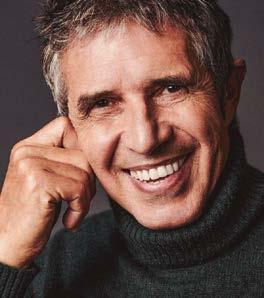
Florence 25-26 November
The Florence Marathon is the second biggest in Italy and one of the most important in the world. Run over a distance of 42 kilometres and 195 metres, it combines sport, history and art. The route through the streets of beautiful Florence attracts thou sands of athletes and followers from across the world. For further information, see www.firenzemarathon.it.

Zénith Toulouse Métropole 25 November
Julien Clerc comes to Toulouse in November. Clerc was playing the piano by the age of six and began to compose songs at university when he got to know Maurice Vallet and Etienne Roda-Gil, two of the main au thors of his songs. He enjoyed a meteoric artistic career and at age 24 his wax figure was already in the Musée Grevin in Paris. He earned five gold discs for his record sales in 1974. He has remained as popular as ever down the years and has devoted much of his time to humanitarian causes. He was appointed a UNHCR Goodwill Ambassador in 2003.
Le Splendid 7 November
Royal Republic are one of the top Swedish rock bands of the last decade, with their talent clearly seen in their album releases to date. The band consists of singer-guitarist Adam Grahn, guitarist Hannes Irengard, bass guitarist Jonas Almén and drummer Per Andreasson. They promise to lay on a truly spectacular concert in Lille.
From 18 to
JEREZ DE LA FRONTERA C-IFECA Exhibition Centre22 October
The city of Funchal has been included on the calendar of inter national races known as EcoTrail, which are a variant of trail running that features an urban circuit.
The race takes place on 22 October. For the next three years, Funchal’s presence on the inter national Eco Trail schedule will place the capital of Madeira on the map of the sport.

Pérez Galdós Museum-House
Until 23 December
Inauguration of the exhibition Galdós in the Laybyrinth of Spain, produced by Acción Cultural España (AC/E), which offers an overview of the pho tography of Pérez Galdós and his era, arising out of his work as a photo-historian. The exhibition presents dozens of the maes tro’s portraits, most of which are shown for the first time here. More information at www. casamuseoperezgaldos.com.
American artist Rashid Johnson is the protagonist of this exhi bition, which is part of the new season at the Hauser & Wirth Gallery in Illa del Rei, Mahón. The exhibition opened back in June and runs until 13 Novem ber. Entitled Sodade (Longing), which is the name of a 1950s song from Cape Verde that speaks of a profound state of emotional nostalgia, the exhibition is Johnson’s first in Spain and draws on critical history and on narratives around jour neys and migrations. It features bronze sculptures and recently created seascapes.
The narrative of this collec tion revolves around a series of images from the archive of Francisco Lora (c.1925-2000) which was donated to CFIT-TEA after his death.

Galería Hauser & Wirth, Menorca


Until 13 November
Until 6 November
The four strands of this exhibi tion help us understand the debt owed by Ruth Orkin’s photogra phy to cinema. Orkin never failed to combine the temporal qualities of the photographic image to simulate film. Sequenc es, decomposition of movement, duplication, simultaneity, … her visual language lies at the junc ture of the photographic image and cinema, at the crossroads of stillness and movement. Orkin’s photography is a melting pot, a space that restores time and movement, pushing photograph ic language beyond its limits until it yields to the power of illusion and magic.
 Kutxa Kultur Artegunea
Kutxa Kultur Artegunea
Until 20 November
This exhibition organised by the Patio Herreriano Museum features a selection of works from what might be considered one of the most important private collections in Europe: the Italian Sandretto Re Re baudengo collection, housed in Turin. The exhibition highlights some of the key issues of the international scene and marks a first step towards confronting Spanish art with the most avant-garde propos als at international level. A revelation. Works from the Sandretto Re Rebaudengo Collection occupies all four rooms on the second floor of the museum. The exhibition addresses themes such as sense of thea tre, staging, origin and motive, all of which are key aspects in any work of art. It also offers a perspective on the role of women in the visual arts from the 1960s onwards, through protest works.


16 November
Until the end of 2022
This collection of 51 works features Galician artists whose pieces feature in international collections (Ángela de la Cruz, Suso Fandiño, Álvaro Negro, Manuel Vilariño and Pedro Barbeito), emerging figures (Sandra Cinto, Andrei Roiter, Shinique Smith, Manuel Caeiro and Yves Oppenheim), artists already consolidated on the contemporary art scene (Jason Martin, Daniel Verbis, Simeón Saiz Ruiz, Günther Forg, Frank Nitsche and Pedro Calapez), and key names from the second half of the 20th century (Imi Knoebel, Jonathan Lasker, Helmut Dorner, Jean-Marc Bustamante and Jessica Stockholder).
Spain has participated in almost all the São Paulo Bien nials since the first one back in 1951. Created by Francisco Matarazzo and inspired by its Venice counterpart, the Biennial soon became one of the major events on the international scene. Due to its great success, it moved in 1957 to the Palacio das Indústrias (Parque de Ibi rapuera), a building designed by Oscar Niemeyer, where it is still held today. Looking at Spain’s participation in the various editions of the Biennial provides a glimpse of the country’s artistic evolution in recent decades. During the Franco dictatorship, the Spanish pavilion was an un paralleled instrument of prop aganda despite the criticism of the regime contained in many works. Following the transition to democracy, Spain’s contri bution gradually incorporated newer tendencies.


 By Francisco Belín Illustrated by Ilustre Mario
By Francisco Belín Illustrated by Ilustre Mario
Yes, it’s September: the month that signals the start of autumn and a second battle of the bulge after a summer in which we have probably indulged in some excesses in terms of food and drink, almost a re-run of Christmas. We know how these excesses end up: a few extra kilos on the scales and our waistlines. However, resuming a healthy diet in the Canary Islands does not necessarily mean we have to endure the hell of the usual diets.
The return to normal daily life means we must say goodbye to the massive meals we have signed up to willingly and face the widely held view that we have to make sacrifices in the form of diets that are too bland and uninteresting.
Gastronomy. Healthy and tasty diet.Why should we have to go without the lovely chunks and fillets of the magnificent tuna that swim in our seas? Or the incredible mackerel that provides everything we need in nutritional terms? Did you know we have six different kinds of tuna year-round and at very competitive prices?
Fish from the Atlantic accompanied by some little potatoes, ‘mojo’ sauce… what luck, or rather, what a diet. In this inflight magazine we have always encouraged people to eat fresh fruit and vegetables. When we speak about local Canarian products we are also referring to the gastronomic subtlety of ingredi ents that, when used in different recipes and food ideas, are not detrimental to taste, unlike many diets including socalled saviour diets.
-
We have six species of tuna yearround in the canaries: a wonderful excuse for healthy eating -
Health trends have become the order of the day of late, albeit perhaps now with less of a focus on formulas based on boiling and grilling, or juices and shakes, and which did little to encourage us to sit down to eat. However, the Canaries have many local products that enable adults and children to return to sensible eating habits and steer clear of nuggets and mass-produced desserts.
The Canary Islands are a shop win dow for a shopping basket that helps make light of dietary demands. No matter how much we want our return to the fold to be tough on us, the range of healthy foods provides alternatives and balanced options based on raw mate rials which are not usually found else -
where. For example, dragon fruits such as the wonderful kind grown in La Palma or Tenerife are of great interest for their nutritional value, even more so when eaten as a dessert on their own: detox, essential minerals, hydration…
The exotic fruits grown in our soils can be used readily in delicious salads; appetising flavours that are ideal served with vegetables, seeds, fresh cheese and other elements containing key nutrients for our health. To give just one example, take a handful of large Canarian prawns from La Santa (Lanzarote) or Arguineguín (Gran Canaria) and cook them lightly. Add watermelon from Tina jo (also Lanzarote) and toss everything in a wok. Shell the prawns and add some salt; perhaps also season with borage flowers… and top it all with a fruity vinegar dressing.
You will surely agree that this is much more appetising than one of those green shakes that we tend to gulp down quick ly, fully convinced that they are infallible. Equally appetising are small pieces of pork from Canarian black pig, Fuerteventura olive oil, and sweet potato from La Palma, Lanzarote’s volcanic ‘jable’ soils or Anaga (Tenerife); or tropical pineapple from El Hierro – why not? – to accompany lightly smoked fish from the Atlantic. These culinary fusions are an invitation to enjoy healthy cooking which is also sustainable (an aspect we will write about at length another time).
To sum up, to eat healthily we don’t need to suffer. Even a cursory glance at our gastronomic heritage will persuade as to the dietary benefits of a ‘puchero’ stew, sundried salted fish, and other elements of what can be considered with good reason to be an Atlantic diet. One in which taste does not need to be sacrificed.
Gastronomy. Healthy and tasty diet.
In June Lanzarote hosted the 2022 Official Agrocanarias Gofio Competition, which is organised by the Canarian Insti tute for Food Quality (ICCA) to acknowledge the best gofios (roasted flourmeal) in the Canaries and showcase one of the flagship foodstuffs of the Islands’ gastronomy. Of the winning entries, deserving of particular mention is the “Gofio Gomero, Gofio Ideal 5” brand - made with wheat, maize, barley, oat and chickpea - which carried off the best Gofio in the Canaries Award.
To compete, the gofios must be made in flour mills in the Canaries with wheat or maize (or blends of these) or be based on other cereals and/or or pulses. In each category, participants competed
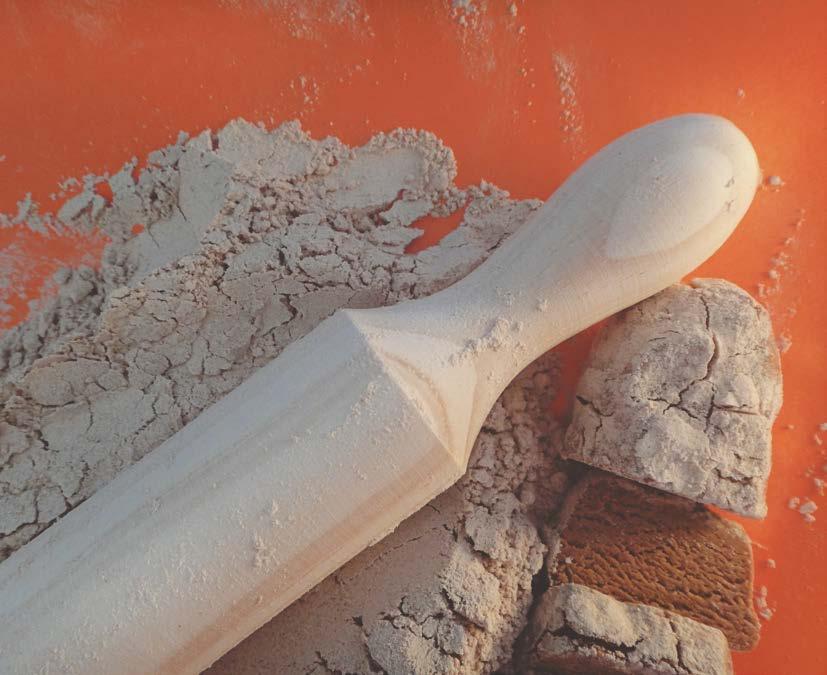
for the Gold, Silver and Bronze medals, and special distinctions awarded included Best Organic Gofio, Best Local Grain Gofio, and Best Image and Presentation among all the entries.
A total of 86 gofios from nineteen mills were entered for the competition. Tenerife entered 32 gofios from seven mills; La Palma two from one mill; La Gomera 18 from two mills; El Hierro three from one mill; Gran Canaria 25 gofios from six mills; Fuerteventura four from one mill; and Lanzarote two from one mill.
Across the different categories there were 20 gofios made from wheat, 27 from maize, 14 from a wheat/maize blend, and 25 from other cereals.
El Cotillo in Fuerteventura is an ideal spot for campers and should be underli ned in red in any decent travel notebook if the aim is to spend a few hours trying wonderful sea food. Of the wide range of places available to eat, one stands out by tradition for its quality ingredients and friendly service.
La Vaca Azul is one of the top restau rants not just in Fuerteventura but also in the entire Canary Islands. Set in a stunning location looking out over the Atlan tic and the old harbour at El Cotillo, here you will enjoy excellent fresh fish and seafood dishes, along with an extensive selection of soups, salads, meats, rice dishes and home-made desserts.

Requena, 9. El Cotillo - Fuerteventura. T. 928 538 685.

The country is renowned for its extraordinary tourism and cultural possibilities, which never fail to surprise and entice.
Morocco is visited every day by hundreds of tourists who choose this hospitable country to enjoy a few days of relaxation and adventure. With its long traditional of crafts and commerce, it never disappoints and Binter’s extensive flight connections are ideal to visit four of its flagship markets.

Traditional markets are a must visit and El Had is one of the most highly recommended. Its more than 6000 shops offer a wide variety of irresistible local products: spices, leather goods, tradi tional clothing, decorative items, etc.


Some of Morocco’s most famous tanners can be found in the heart of the medina in Fez. The Chouwara Tannery is the biggest in the country and has countless stone vessels filled with natural dyes of different colours. The colourful experience of viewing lamb, ox, goat and camel skins hanging to dry before being made into handbags, shoes, coats and suitcases by the artisans is enhanced by the characteristic smell of the tanning work.
Modern Morocco is to be found in Marrakesh. Much of the social life of the population takes place in and around Jemaa El-Fna Square, whose uniqueness led Unesco to declare it an example of world intangible cultural heritage. A stroll here is a must both at night and by day.
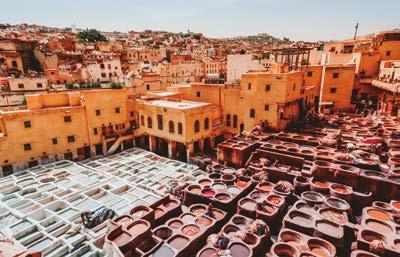
The camel market is one of the main tourist attractions of this small town, which is known as the «Gateway to the Desert». The charm of this exotic market is increased by the presence of the socalled «blue men of the desert», traders whose blue robes cause their skin to take on the same colour.
 The El Had zouk is home to an endless variety of spices and products.
Visitors can learn about the traditional art of tanning in the tanneries.
Jemaa El-Fna is the main square in Marrakesh and one of the city’s iconic spots.
Camels are of great cultural and historic importance in Morocco, particularly in Guelmim.
The El Had zouk is home to an endless variety of spices and products.
Visitors can learn about the traditional art of tanning in the tanneries.
Jemaa El-Fna is the main square in Marrakesh and one of the city’s iconic spots.
Camels are of great cultural and historic importance in Morocco, particularly in Guelmim.
Now healthier, fresher and more varied, with products from the Canaries




Nocilla chocolate spread, jam, cheese, and sticks, digestive biscuit, brioche roll, white/brown bread roll, chocolate wafer biscuit
Fruit compote available for babies
Fruit salad, jam, brioche roll, butter, cheese, and chocolate wafer biscuit
White coffee, orange and Canarian banna natural fruit juice and bread
Iberian charcuterie, houmous, Canarian cheeses, vegetables, white/brown bread roll, chocolate wafer biscuit
Houmous, salmon or chicken paté, Canarian cheeses, vegetables, white/brown bread roll, chocolate wafer biscuit
Only available on ATR aircraft*
Selection of focaccia breads, fruit juices and chocolate wafer biscuit

Menus subject to change for operational reasons. Fresh products rotated according to reason.
Aircraft operates routes to Madeira and certain African destitanions. Space restrictions may affect the availability of drinks during the ight. We apologise for any inconvenience caused.




Fancy sharing your Binter experience?
If you love taking in the scenery while flying, share your pictures on social media and tag them using #FlyingwithBinter. The best photos will be published in our magazine and on Facebook, Twitter and Instagram. Don’t forget to use the tag. Enjoy the flight!


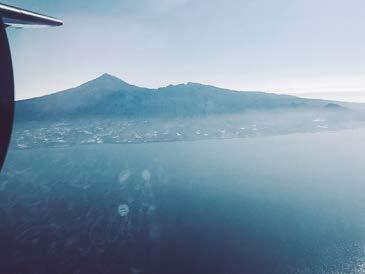 @javi_carmo_
José A Rilo López
@doc7austin0trains
@GuilleGarciacan
@javi_carmo_
José A Rilo López
@doc7austin0trains
@GuilleGarciacan

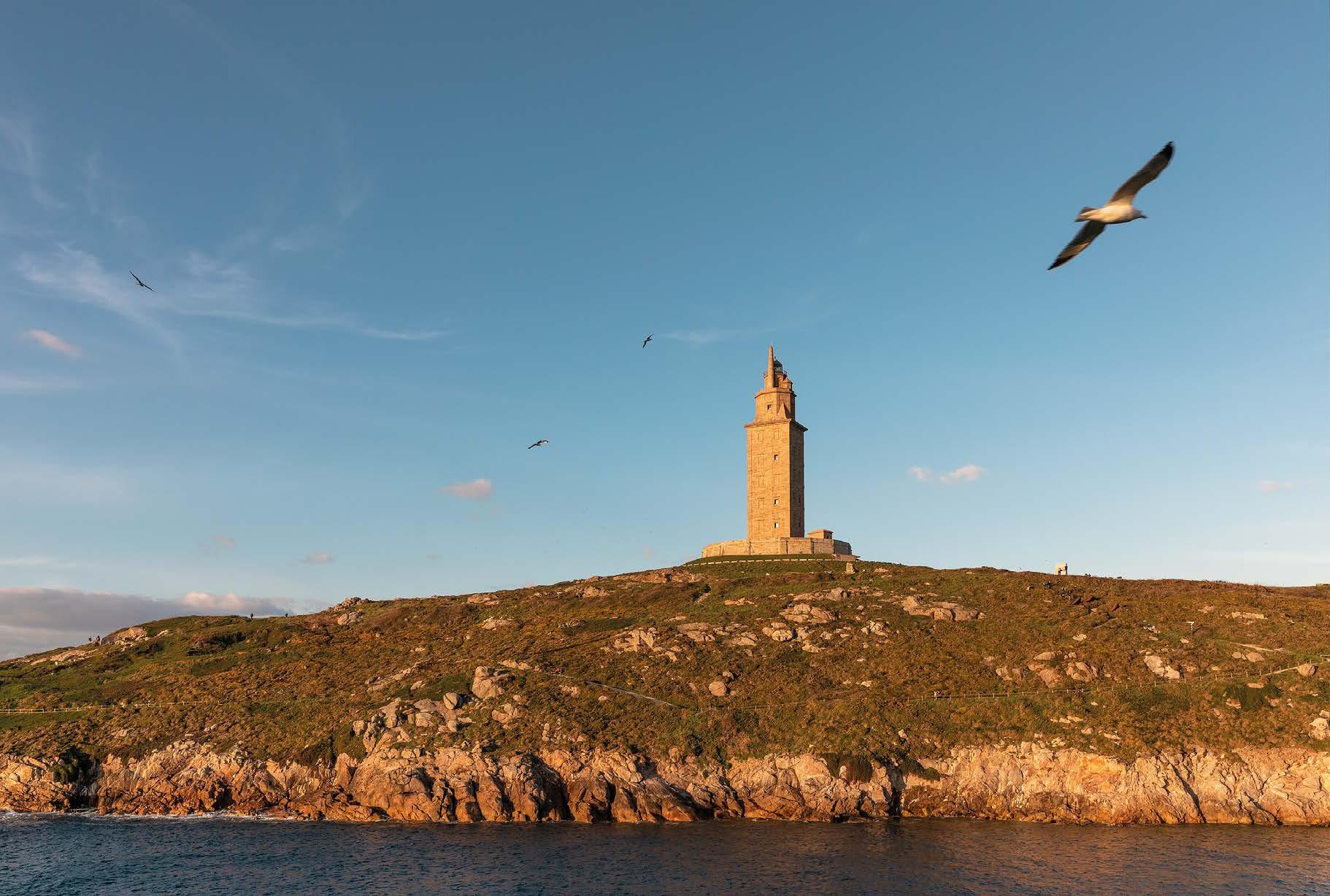

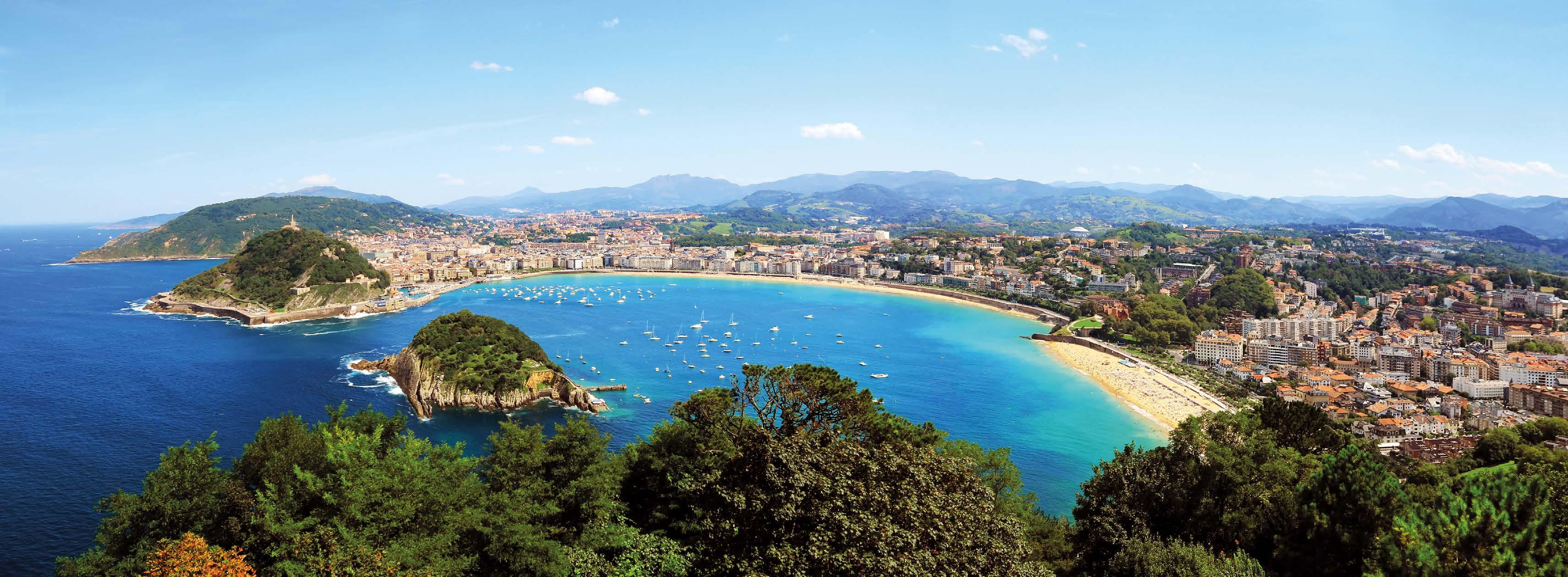








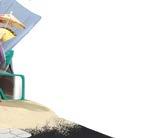










,
on the BinterMás
 Barceló
* Issue of card subject to study and approval by Santander Consumer Finance S.A.
Barceló
* Issue of card subject to study and approval by Santander Consumer Finance S.A.
Earn double points when you stay in Abora by Lopesan Hotels and enjoy an all-inclusive family holiday.

Abora by Lopesan Hotels
Abora Interclub Atlantic 260 + 260 points/night
Abora Buenaventura 260 + 260 points/night
Abora Catarina 260 + 260 points/night
Abora Continental 260 + 260 points/night
lopesan.com 902 450 010
Valid: book until 30/09/2022 and stay in September and October 2022. Subject to availability.
Situated in the very heart of the harbour at Puerto Rico, Marina Suites invites you to enjoy double points and a seafront holiday in south Gran Canaria.
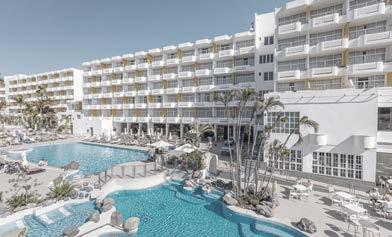
Hotel
Marina Suites 215 + 215 points/night
marinagrancanaria.com 928 153 015
Valid: September 2022.
Earn double points in the Iberostar Selection Sábila 5* hotel and enjoy exclusive discounts in our Gourmet Market.
Earn
Iberostar
Exclusive benefit
Discount in Gourmet Market. BinterMás cardholders: Green 5% disc. Gold & Silver 10% disc.
Earn double points in selected Dunas Group hotels. BinterMás Gold and Silver cardholders also benefit from free late check-out.
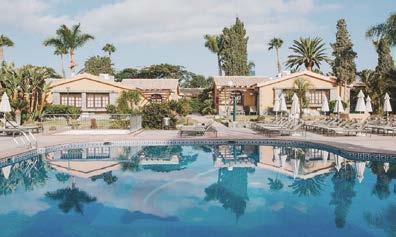

Hotels
Suite
Maspalomas
Exclusive
Late check-out*
iberostar.com 902 995 555 hotelesdunas.com 902 142 828
Valid: September 2022. Adults Only hotel.
+
BinterMás Gold and Silver cardholders.
Valid: September 2022. *Subject to availability.
Iberostar Selection Sábila 5* (Gourmet Market). Tenerife Abora Catarina by Lopesan Hotels. Gran Canaria Suite & Villas by Dunas 4*. Gran Canaria


BINTER 922/928 327 700 bintercanarias.com
Earn: from 100 to 1000 points
IBERIA 902 400 500 iberia.com Earn: from 75 to 300 points
CAR HIRE
CICAR 928 822 900 cicar.com
Earn: from 40 to 100 points
AVIS 902 135 531 avis.es
Earn: from 50 to 75 points
CANARIASVIAJA 922 24 81 61 canariasviaja.com Earn: 1 point per 1 €
TALASOTERAPIA LAS CANTERAS 928 271 170 talasoterapialascanteras.com Earn: 40 points/circuit
PETROL STATIONS
DISA 901 101 016 disagrupo.es Earn: up to 50 points
FINANCE
BINTERMÁS MASTERCARD santanderconsumer.es Obtención: 1 punto por 2 €
CANARIENSIS 900 252 423 aldeasa.com Earn: 120 points for 30 € spent
GOLF RESORT 928 94 30 04 salobregolfresort.com Earn: 100 points
SOCIAL
UNICEF 928 269 293 unicef.es Donation of 300 to 500 points
ARRECIFE GRAN HOTEL & SPA 928 800 000 aghotelspa.com Earn: 300 points
BARCELÓ HOTEL GROUP 902 101 001 barcelo.com
Earn: from 125 to 400 points
BUENDÍA
CORRALEJO NOHOTEL 928 943 027 buendiacorralejo.com Earn: 215 points
CORAL HOTELS 928 327 700 coral-hotels.com
Earn: from 160 to 560 puntos
HOTEL CORDIAL MOGAN PLAYA 928 143 393 becordial.com Earn: 470 points
DREAMPLACE HOTELS & RESORTS 902 210 902 dreamplacehotels.com
Earn: from 200 to 600 points
DUNAS HOTELS & RESORTS 902 142 828 hotelesdunas.com Earn: from 300 to 500 points
GLORIA THALASSO & HOTELS 928 128 505 gloriapalaceth.com Earn: from 300 to 430 points
GOLD BY MARINA 928 948 555 goldbymarina.com Earn: 215 points

SECRETS BAHÍA REAL 928 537 153 secretsbahiareal.com Earn: 600 points
H10 HOTELS
900 444 466 h10hotels.com
Earn: from 250 to 420 points
HOTELES ELBA 902 172 182 hoteleselba.com Earn: from 140 to 800 points

HOTEL PARQUE TROPICAL 928 774 012 hotelparquetropical.com Earn: 200 points
IBEROSTAR HOTELS & RESORTS 902 995 555 iberostar.com Earn: from 100 to 200 points
LOPESAN HOTELS & RESORTS 902 450 010 lopesan.com Earn: from 150 to 325 points
MARINA GRAN CANARIA 928 153 015 marinagrancanaria.com Earn: 215 points
MELIÁ HOTELS INTERNATIONAL 912 764 747 melia.com Earn: from 100 to 200 points
MUR HOTELS 928 24 13 37 murhotels.com Earn: from 260 to 290 puntos
R2 HOTELS 928 546 054 r2hotels.com Earn: from 200 to 300 points
SALOBRE HOTEL RESORT 928 943 000 salobrehotel.com Earn: 340 points

SHERATON FUERTEVENTURA BEACH, GOLF & SPA RESORT 928 495 100 sheraton.com/fuerteventura Earn: 640 points
VILA BALEIRA +351 291 980 800 vilabaleira.com Earn: 165 points
bintermas.com or call 922/928 327 700.


